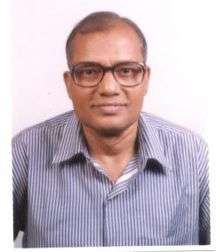Binod Bihari Verma
| Binod Bihari Verma | |
|---|---|
 Dr Binod Bihari Verma, May 2000, Bhubaneswar | |
| Born |
Binod Bihari Verma 3 December 1937 Baur, Distt Darbhanga, Bihar, India |
| Died |
9 November 2003 (aged 65) Bangalore, Karnataka, India |
| Pen name | Vinod, Vinod Gopal |
| Occupation | Writer: novelist, short story, biography, research; medical doctor; armyman |
| Nationality | Indian |
| Period | 1965–2005 |
| Genre | Rural life, social justice, historical |
| Subject | Genealogy, Folk songs, biography, Literary criticism |
| Notable works | Maithili Karna Kayasthak Panjik Sarvekshan |
| Spouse | Pratibha Verma (1965 – till death) |
| Children | 5: Two sons, Three daughters |
| Relatives | Brij Kishore Verma Manipadma (Cousin Brother) |
Binod Bihari Verma (1937–2003) was a Maithili littérateur by soul, medical doctor by profession and a defence officer by career. He is most noted for his pioneering work on Panjis, which are ancient genealogical charts, Maithili Karna Kayasthak Panjik Sarvekshan. He is also known for his depiction of rural poor of the Mithila region in his writings. During his lifetime, he worked as a medical officer in the Indian Army, as a lecturer in a Dental College, and as a Private Medical practitioner. He simultaneously carried on his literary works by independent publishing and in various magazines viz. Mithila Mihir and Karnamrit. He had command over a number of languages including Urdu, Sanskrit, Odia, Assamese and Bengali and scripts of various Indian languages viz. old Maithili, Assamese, Gurmukhi, Odia and Nepali.
Biography
Early life and education
Binod Bihari Vema was born in Baur, Darbhanga district, Bihar on 3 December 1937 to Rameshwar Lal Das and Yogmaya Devi. His father was a freedom fighter, a prominent Gandhian and tireless worker for the upliftment of the poor, and he inculcated these values in his children as well.
Verma attended primary school in the village of Rasiyari village. He then travelled with his father and uncle as they were trying to spread Gandhi's message of achieving freedom through self-reliance and non-violence in the remote tribal areas of Chaibasa, Ranchi, and Singhbhum in South Bihar. He developed an empathy with the tribal children and an insight into the diversities of human nature.
Verma's education continued at the District School in Chaibasa, the missionary school of St. John's at Ranchi, and at Langat Singh College in Muzaffarpur. Subsequently he joined the Darbhanga Medical College and graduated in 1962.
Army life
In 1962, during the Sino-Indian War, Verma joined the Indian Army. He was commissioned into the Army Medical Corps in 1963 and served in areas such as Himachal Pradesh, Sikkim, Punjab, Assam and Goa.
Verma fought in the Indo-Pakistani War of 1965 and in 1984 he took a permanent commission in the army. He was involved in Operation Bluestar in 1984 and the IPKF operations in Sri Lanka in 1988–1990, where he commanded the 404 Field Ambulance at Vavuniya. He took early retirement from active army service in 1990, partly disillusioned with the war in Sri Lanka.
Later life and death
Subsequent to his retirement, Verma settled in Bhubaneswar, Orissa where he started a clinical practice. Having long been involved in research and writing, it was in this period that he regularly published novels, biographies, and contributions to Maithili magazines. He taught Biochemistry in a dental college in Bhubaneswar.
In 1999 he was diagnosed as suffering from prostate cancer. He died on 9 November 2003 at Bangalore.
Writing
Early writings
Verma began writing stories and poems during his school days. These were autobiographical and observational, reflecting his life and the people whom he met. He also wrote poems which were patriotic and motivational. These works were published in various school magazines and occasionally in Mithila Mihir, a magazine whose audience was the Kayastha community.
He began contributing regularly to various other Maithili magazines, as well as Mithila Mihir. These depictions of rural life were published as a short story collection titled Balanak Bonihar O Pallavi. He also wrote a social novel, Nayanmani, which was initially published in serial format in Mithila Mihir.
Panjik sarvekshan
In 1973, he published his magnum opus, Maithili Karna Kayasthak Panjik Sarvekshan. This work was a culmination of months of extensive research on the fast disappearing ancient genealogical charts. It remains the only surviving record of certain groups of Panjis, which have now disappeared. In this work, his association with Radha Krishna Choudhary, came to the fore.
Later works
Subsequent to Maithili Karna Kayasthak Panjik Sarvekshan, there came a long hiatus in his literary life. He again started writing and publishing after 1990, after his retirement from the Army. He published his previous works as collections. He also started contributing frequently to Karnamrit, a new maithili magazine, as Mithila Mihir had stopped being published. He researched extensively on folks songs of mithila, the life and contribution of George Abraham Grierson, the biography of Radha Krishna Choudhary, and the literary history of Maithili. These culminated in various articles in the Karnamrit as well as various published books.
Pen names
- Vinod
- Vinod Gopal
Family
Verma married Pratibha Verma on 4 July 1965 at Patori village. The couple had three daughters and two sons.
Major works
- Maithili Karna Kayasthak Panjik Sarvekshan – a survey of the Panjis of the Karan Kayasthas of Mithila. 1973, Madhubani.[1]
- Nayanmani, a novel describing the rural scene in Post Independence bihar.Initially published in parts in "Mithila Mihir" from February 1968 to April 1968. 1997, Bhubaneswar.
- Balanak Bonihar O Pallavi – a short story collection on the village life of Mithila on the banks of the Kosi River and its tributaries. 1994. Bhubaneswar.[2][3]
- Tapasa vai Ganga – biography of Radha Krishna Choudhary. 1995, Bhubaneswar.
- Adim Purkha – translation of Sahitya Akademi award-winning Oriya novelist Gopinath Mohanty's work "Dadi Burha". 2001, Sahitya Akademi, New Delhi.
- Vedmurti Taponishth SriRam Sharma Acharya – biography of Shriram Sharma Acharya. 2005, Bhubaneswar.